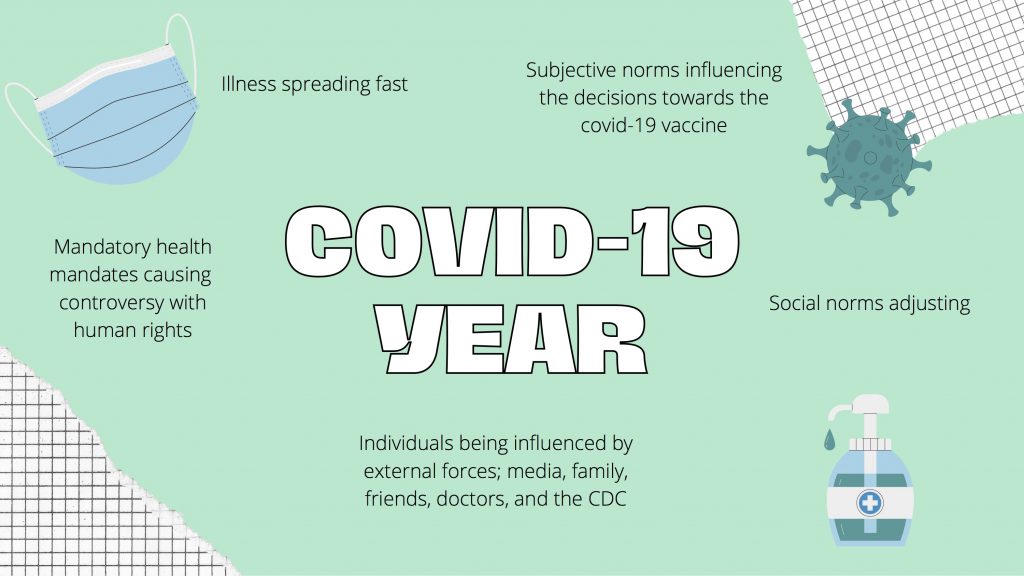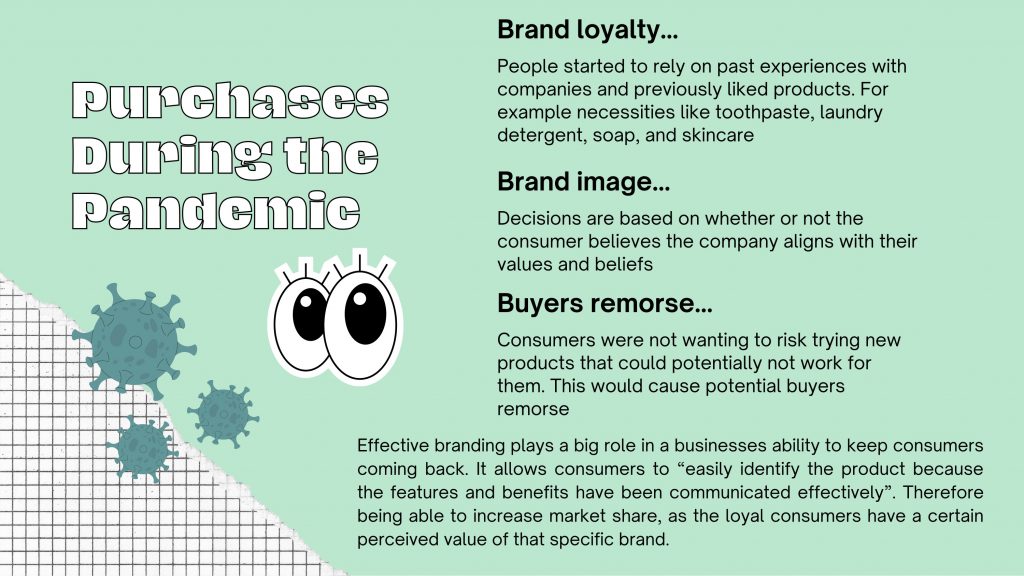Understanding Norms, Attitudes, and Brands in Pandemic Times
The coronavirus has changed the lives of everyone around the world. Illness was spreading fast, borders were closing, and governments had to think quickly. The first step was to figure out what we could do to stop the spread of the virus, while medical teams scrambled to make safe vaccines. Mandatory health mandates were put in place; masks were mandatory for when we socialized with non-household members; social distance became the new norm; borders were closed, and regulated province-wide restrictions were set in place. Overall, there were countless new rules, and over time, our thoughts and opinions started to influence our judgements.
Whether we are aware of it or not, we are constantly being influenced by external forces. These influences can come from friends and family, social media, reporters, and public health officials, for example. During the pandemic, many people have been influenced by those most knowledgeable about health-related matters (e.g., vaccine safety and mask effectiveness) while others have been influenced by news reporters and media (who can be seen as a more reputable source of information).
It is clear that individuals are often influenced most by those whom they are closest to. Consequently, if their family and friends believe that masks and vaccines are essential in keeping us safe, they will be influenced to believe that as well.

Changing Norms
Social norms “generalize the accepted way of thinking, feeling, and behaving in a way that our groups support” (Niosi, n.d.). Social norms tend to be more widely accepted standards like shaking hands when meeting someone, and saying “bless you” when someone sneezes. Some social norms have changed due to the pandemic, such as elbow bumping instead of shaking hands, and maintaining social distance in public. Additionally, during the pandemic, we have been vulnerable to more subjective norms. Subjective norms refers to “the degree of social pressure an individual feels regarding the performance or non-performance of a specific behaviour” (Ajzen, 1988). Additionally, “subjective norms are influenced by one’s perception of the beliefs based on parents, friends, partners, acquaintances and colleagues” (Niosi, n.d.).
During the pandemic, I often found myself feeling conflicted with my choices and actions based on the diversity of opinions from my family and friends. I often felt conflicted as I have multiple friends that are against the vaccine and wearing a mask; as well as having a family that is very proactive with doing their best to stay safe. This left me feeling the social pressure of agreeing with my family’s decisions, yet also feeling like I had to mask those decisions from my friends’ opposing opinions. In the end I made the choices that I agreed with, and believed were best for myself. However, I felt as if I had to keep those decisions private, to keep peace with those friends who did not agree. Although there were no issues between my decisions and my friendships, it still altered my internal thought process on whether or not I was making the right decisions. This displays that I truly was being influenced by my perception of the beliefs of my family and friends.
The Theory of Planned Behaviour
Behind the choices that people make are the attitudes that shape their behaviour. “Attitudes are important because they frequently (but not always) predict behaviour” (Niosi, n.d.). For example, a person who has received all of their recommended vaccines, and gets yearly flu shots is highly likely to get their COVID-19 vaccine. In contrast, a person who does not get their flu shot and displays negative thoughts towards vaccines, is much less likely to get their COVID-19 vaccine.
Attitudes, subjective norms, and perceived behavioural control all take part in what choices an individual makes. These three terms make up the theory of planned behaviour which affects the relationship between attitude-behaviour.
- Attitudes – how we feel towards a certain behaviour
- Subjective Norms – the thoughts/opinions of people who we value
- Perceived Behavioural Control – the degree to which can execute a certain action
During the pandemic, you can see where different attitudes towards government mandates and COVID-19 vaccinations may negatively affect the progress of slowing down the spread of the virus. The two opposing attitudes that stood out the most to me were the group of people that agreed with the rules to control the spread of the virus and are pro-vaccine (group A), versus the opposing group who believe that the government is trying to control our lives, and take away our individual rights (group B).
Although many people make up “group A”, the number of “group B” members are responsible for whey the virus continues to spread. At the time of writing, the overwhelming majority of infected cases are the same individuals who have not received a vaccine and continue to disregard public health recommendations on masking, social gatherings, and non-essential traveling.
Branding in Pandemic Times
There are many different factors that influence our consumer decisions, including aspects of our personality that we wish to see reflected in our purchases. Since the beginning of the pandemic, many businesses have experienced economic turmoil due to stricter government guidelines that reduce product imports and limited product development. Businesses have had to do everything in their power to stay relevant. This meant doing their best to keep their consumers coming back and shifting their advertising messaging to acquire new consumers. Two concepts that I believe play a major role in how businesses stayed afloat during the pandemic are brand loyalty, and brand image.
Brand loyalty is a term that refers to a “consumer’s commitment to repurchase a particular brand despite having other options available to them” (Niosi, n.d.), and brand image is a “symbolic construct created within the minds of people, consisting of all the information and expectations associated with a product, service, or company providing them” (Niosi, n.d.).
During the pandemic, my purchases solely relied on my past experiences with companies and previously used products, as well as whether or not I believed the company followed my beliefs in ethical practices. I often found myself repurchasing skincare that I have been using for the past two years, due to the fact that I knew those products worked very well for me. I also did not want to risk trying new products that could possibly not work as well, therefore potentially being a waste of my money. During the pandemic when most people were out of work, this was not an option I was willing to gamble on. In my point of view, brand loyalty works cohesively, as the products that I choose to purchase often fall in line with my belief in sustainable and ethical practices. This includes clean products that do not contain harmful chemicals, as well as brands that are doing their part to ethically source their ingredients and supplies.
Aside from skincare, these concepts are also interrelated to commonly purchased products like body wash, toothpaste, clothing, and food. It was almost second nature to purchase products from companies that I previously bought from. This shows how easily consumers become loyal to products and brands that generate positive experiences. Overall, effective branding truly plays a big role in a business’ ability to keep consumers coming back, especially during a pandemic when most shopping experiences shifted to necessity purchases. It allows consumers to “easily identify the product because the features and benefits have been communicated effectively” (Niosi, n.d.).

By Kirsten McInnes (2021, August)
| Norms | Brand | Behaviour | Perception | Loyalty |
| Influence | Attitudes | Consumers | Branding | Image |
| B | R | A | N | D | I | N | G | K | B |
| S | X | N | L | O | Y | A | L | T | Y |
| S | I | O | U | O | Z | N | P | I | A |
| Q | S | R | E | M | U | S | N | O | C |
| T | I | M | A | G | E | H | U | L | F |
| W | C | S | I | Y | Z | Z | T | S | T |
| P | E | R | C | E | P | T | I | O | N |
| Z | E | C | N | E | U | L | F | N | I |
| L | S | E | D | U | T | I | T | T | A |
| B | E | H | A | V | I | O | U | R | J |
Text Attribution
- Niosi, A. (n.d.). Introduction to Consumer Behaviour is licensed under CC BY-NC-SA-4.0.
References
Ajzen, I. (1988). Attitudes, Personality, and Behavior. Chicago, IL: Dorsey Press.
refers to the actions that we partake in during our everyday lives that are viewed as acceptable within society. They generalize the accepted way of thinking, feeling, and behaving in a way that our groups support.
the degree of social pressure an individual feels regarding the performance or non-performance of a specific behaviour.
how we feel towards a certain behaviour.
the degree to which can execute a certain action.
a consumer’s commitment to repurchase a particular brand despite having other options available to them.
a symbolic construct created within the minds of people, consisting of all the information and expectations associated with a product, service, or company providing them.

